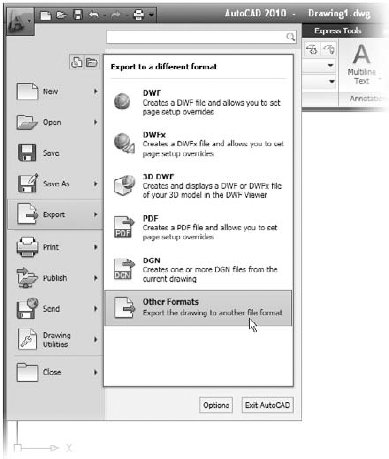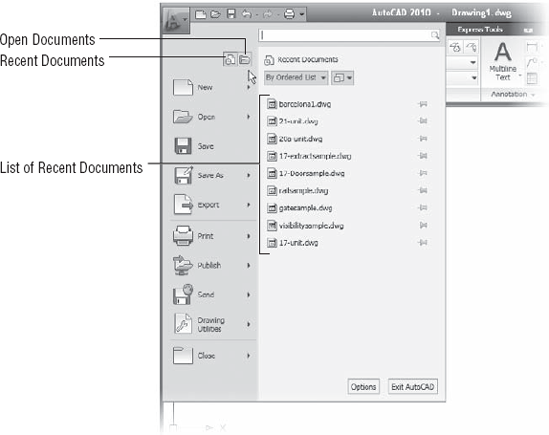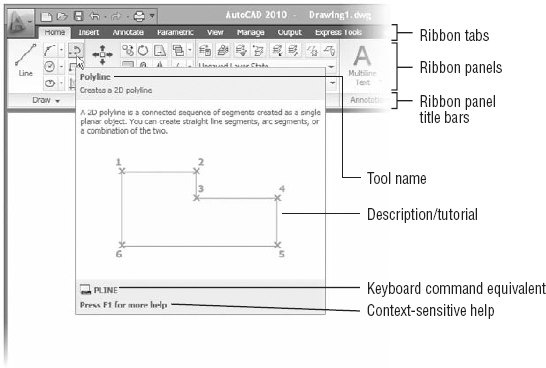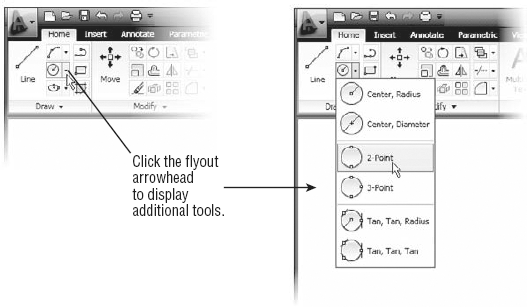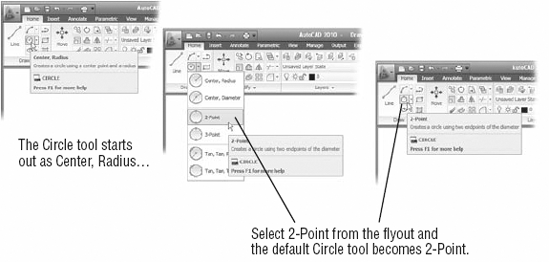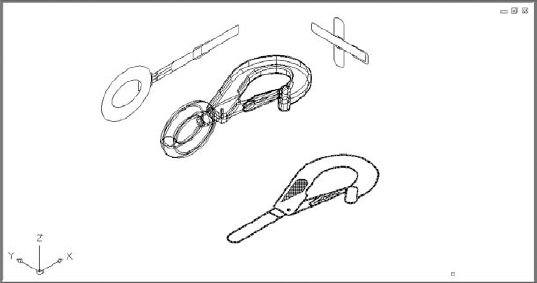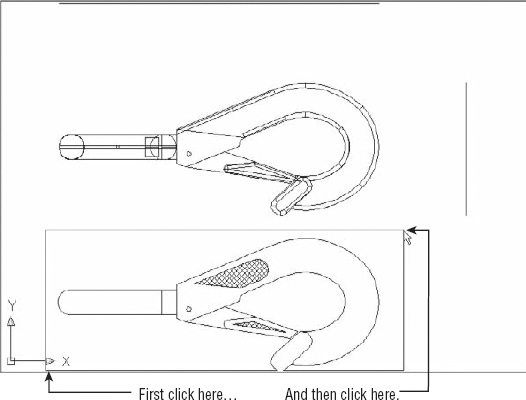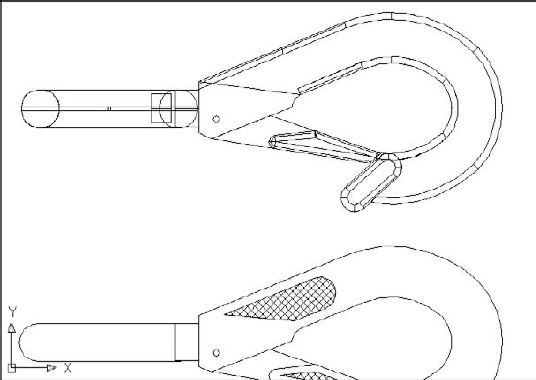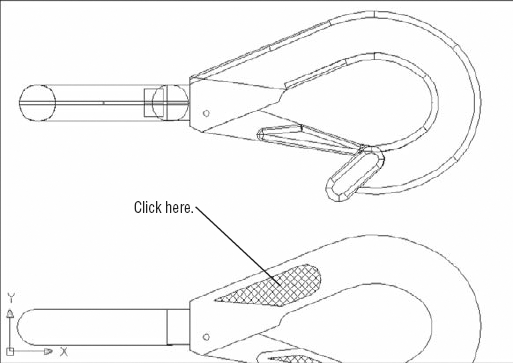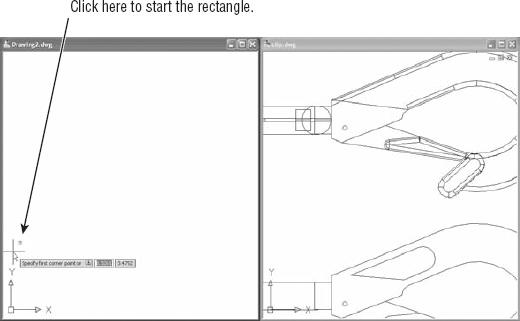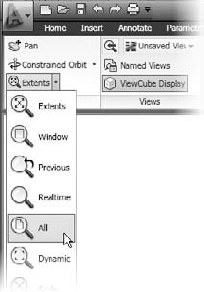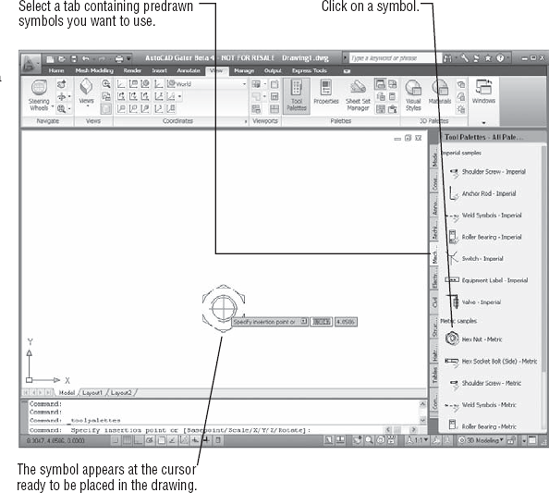Before you can start to use AutoCAD 2010's new capabilities, you'll need to become familiar with the basics. If you're completely new to AutoCAD, you'll want to read this first chapter carefully. It introduces you to many of AutoCAD's basic operations, such as opening and closing files, getting a close-up look at part of a drawing, and changing a drawing. If you're familiar with earlier versions of AutoCAD, you should review this chapter anyway to get acquainted with the features you haven't already used.
Autodesk releases new versions of AutoCAD every year. Part of this strategy is to introduce improvements that focus on a particular category of features. This latest version, AutoCAD 2010, includes several new features that have been on wish lists for quite some time. Three of the major new features are parametric drawing (Chapter 17), free-form design in 3D with mesh modeling (Chapter 25), and enhanced PDF support including snap-to-geometry PDF backgrounds (Chapter 14).
You'll get a chance to explore these new features and many more as you work through this book. Before you begin the exercise later in this chapter, make sure that you have loaded the sample files from this book's companion DVD. See the introduction for details.
In this chapter, you'll learn about the following topics:
Use the AutoCAD window
Get a closer look with the Zoom command
Save a file as you work
Make changes and open multiple files
In this section, you'll get a chance to familiarize yourself with the AutoCAD screen and how you communicate with AutoCAD. As you do the exercises in this chapter, you'll also get a feel for how to work with this book. Don't worry about understanding or remembering everything you see in this chapter. You'll get plenty of opportunities to probe the finer details of the program as you work through the later chapters. To help you remember the material, you'll find a brief set of questions at the end of each chapter. For now, just enjoy your first excursion into AutoCAD.
If you already installed AutoCAD and are ready to jump in and take a look, proceed with the following steps to launch the program:
Choose Start

In fresh installations of AutoCAD, you'll see the Initial Setup dialog box. For now, click the Skip button since I'll be discussing the basic AutoCAD functions.
At the Skip Initial Setup page, click the Remind Me the Next Time AutoCAD 2010 Starts option to turn it off. You can always get to the Initial Setup dialog box later if you need to use it.
Click the Start AutoCAD button in the next dialog box to start AutoCAD.
The opening greeting, called a splash screen, tells you which version of AutoCAD you're using, to whom the program is registered, and the AutoCAD dealer's name and phone number, should you need help. If this is the first time you've started AutoCAD after installing it, you'll also see a dialog box asking you to register the product.
You may also see the New Features Workshop window, which offers a set of tutorials showing you the new features of AutoCAD 2010. Click the No, Don't Show Me This Again or Maybe Later radio button, and click OK. You can always get to the New Features Workshop screen from the AutoCAD Help window by pressing the F1 function key.
The AutoCAD window displays a blank default document named
Drawing1.dwg, as shown in Figure 1.1. Although it doesn't appear in Figure 1.2 because I wanted to show more of the drawing area, AutoCAD users may see the Sheet Set Manager palette to the left of the AutoCAD window. LT users may see the Info palette to the left of the AutoCAD window.
If this is the first time you've started AutoCAD since you installed it, you're asked to register and authorize AutoCAD in step 2. If you're using the trial version, you can use the default serial number 000-00000000 for the one-month trial. After you've entered the registration information, you see the New Features Workshop window described in step 6.
Now let's look at the AutoCAD window in detail. Don't worry if it seems like a lot of information. You don't have to memorize it, but by looking at all the parts, you'll be aware of what is available in a general way.
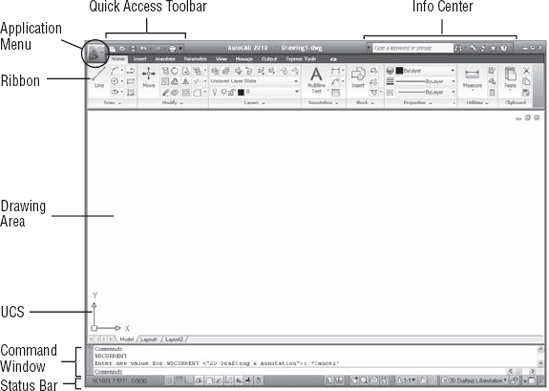
Figure 1.1. A typical arrangement of the elements in the AutoCAD window. The Sheet Set Manager palette (or Info palette for LT) is closed for clarity.
The AutoCAD program window is divided into six parts:
Figure 1.1, shown earlier in this chapter, shows a typical layout of the AutoCAD program window. You can organize the AutoCAD window into any arrangement you want and save it as a workspace. You can save and recall a workspace at any time using the Workspace Switching tool in the status bar (you'll learn more about this tool in the next chapter). The default workspace in Figure 1.1 is called the 2D Drafting & Annotation workspace, which is one of two workspaces built into AutoCAD.
Figure 1.2 shows AutoCAD's 3D Modeling workspace, which has a different set of screen elements. Figure 1.2 also shows a standard AutoCAD drawing file with a few setting changes to give it a 3D appearance. Beneath these external changes, the underlying program is the same.
You'll learn more about workspaces later in this chapter and in Chapter 28.
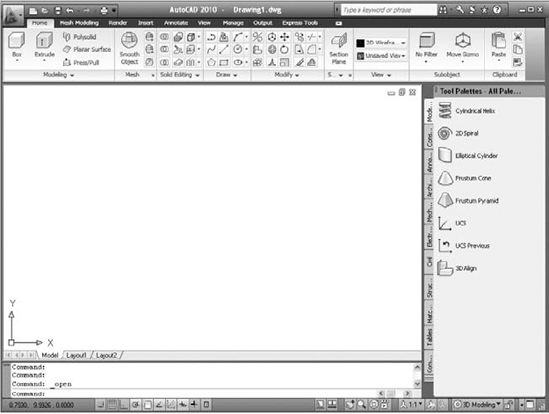
Figure 1.2. The 3D Modeling workspace offers an alternative arrangement of the elements in the AutoCAD window.
In the upper-left corner of the AutoCAD program window, the red AutoCAD icon features the Application menu, which offers a set of options not directly related to drawing; I'll elaborate on this new menu in the next section, "Using the Application Menu." The Quick Access toolbar at the top of the drawing area (as shown in Figure 1.3) includes the basic file-handling functions that you find in nearly all Windows programs. The InfoCenter is AutoCAD's online help facility; you'll learn more about it in Chapter 2. The Ribbon provides nearly all the commands you'll need using icon tools; you'll learn more about the Ribbon in the section "Using the Ribbon" later in this chapter.

Figure 1.3. The Quick Access toolbar, featuring basic Windows file-handling functions, appears above the Ribbon.
The drawing area occupies most of the screen. Everything you draw appears in this area. As you move your mouse around, crosshairs appear to move within the drawing area. This is the drawing cursor that lets you point to locations in the drawing area. You'll get your first chance to work with the drawing area later in the section "Picking Points in the Drawing Area." You'll learn more about the UCS icon in a moment (see the section "Using the UCS Icon").
Just below the drawing area in the lower-right corner are the Model and Layout tabs. These tabs enable you to quickly switch between different types of views called the model and layout views. You'll get to see firsthand how these work in a section called "Working with AutoCAD" later in this chapter.
The Command window, located just below the drawing area, gives you feedback about AutoCAD's commands as you use them. You can move and resize this window just as you move and resize other display components. By default, the Command window is in its docked position, as shown in Figure 1.4. I'll elaborate on the Command window in the section "Working in the Command Window" later in this chapter.
Below the Command window is the status bar (also shown in Figure 1.4). The status bar gives you information at a glance about the state of the drawing. For example, the coordinate readout at the far left of the status bar tells you the location of your cursor. The tools in the status bar offer aids to the drafting process.
The Application menu offers tools to help you manage your AutoCAD files. It is basically the File pull-down menu from previous versions of AutoCAD. Try it out to see how it works firsthand:
Click the Application menu icon. A list of options appears.
Move the highlight cursor slowly down the list of options in the left column. As you highlight the options, additional options appear in a column to the right.
Highlight the Export option to see the different formats available for export (see Figure 1.5).
The Application menu also gives you a convenient way to find recently used files or to get to a file you already have open. If you move your cursor away from the list of options to the left in the Application menu, you'll see Recent Documents in the upper right of the menu. You'll also see two icon tools named Open Documents and Recent Documents (see Figure 1.6).
The Open Documents option lets you quickly change from one open file to another when you are viewing your files full-screen. The Recent Documents option displays a list of documents you've recently worked on.
You can use the View tool in the upper-right portion of the Application menu to select the way the list of files is displayed in a manner similar to the way you would use the Windows Explorer View option. You can click this icon and select Medium Images to have the list display the files with thumbnail images of their content. Hover over a filename, and you will see a tool tip that displays a larger thumbnail of the drawing.
The most prominent feature in the AutoCAD window, besides the drawing area, is the Ribbon (see Figure 1.7). This is where you'll be selecting tools to draw, edit, or perform other functions. The Ribbon contains a set of panels representing groups of tools and features. The name of each Ribbon panel is found in its title bar at the bottom of the panel. Ribbon panels are further organized by the tabs that appear above them. All of the tools in the Ribbon offer tool tips that provide a short description to help you understand what each tool icon represents.
If you see only the Ribbon tabs, right-click one of the tabs and choose Minimize
Move the arrow cursor onto one of the Ribbon panel tools and leave it there for a moment; you'll see a tool tip appear just below the cursor. Hold the cursor there a bit longer and the tool tip changes to give you even more information about the tool.
In most cases, you'll be able to guess what each tool does by looking at its icon. The icon with an arc in the Draw Ribbon panel, for instance, indicates that the tool draws arcs; the one with the circle shows that the tool draws circles; and so on. For further clarification, the tool tip gives you the name of the tool.
As a new user, you'll find these tool tips helpful because they show you the name of the tool and a brief description of how to use it. Typically, when I ask you to select a tool, I'll use the name shown in the tool tip to help you identify the tool. In the case of a tool with flyouts, the tool name changes under different conditions. For those tools, I'll describe the tool using a general description. You'll learn more about flyouts a bit later in this chapter (see the section "Understanding Flyouts").
As you work through this book, I will ask you to select tools from the Ribbon panels. You'll often be asked to switch between different tabs to select tools from other sets of panels. To make the process simpler to read, I'll use a somewhat abbreviated description of a tools location. For example, to use the Line tool, I'll say, "Click the Line tool from the Home tab's Draw panel." To use the Move tool, I'll say, "Click the Move tool in the Home tab's Modify panel."
In addition to the visible tools, a few tools are hidden from view. You can expand many of the Ribbon panels to select more tools. If you see an arrowhead to the right of a panel's title bar, you can click the title bar to expand the panel (see Figure 1.8). The set of tools expands to reveal some additional tools. If you click in the drawing area, the expanded panel shrinks to its original size. As an alternative, you can click the pushpin icon in the expanded panel title bar to lock the panel in its open position.
From now on, I'll refer to the location of additional tools as the "expanded panel." For example, I'll say, "Click the Ray tool in the expanded Draw panel" when I want you to select the Ray tool.
One more feature you'll want to know about are the flyouts. Flyouts are similar to the expanded panels because you can click an arrowhead to gain access to additional tools. Instead of a whole panel, however, flyouts give you access to different methods for using a particular tool. For example, AutoCAD lets you draw circles in several different ways, so it offers a flyout for the Circle tool in the Home tab's Draw panel. If you click the arrowhead next to the circle icon in the Draw panel, you'll see additional tools for drawing circles (see Figure 1.9).
If you select a tool option from a flyout, that option becomes the default tool for that icon. For example, if you hover your cursor over the circle icon in the Draw panel, you'll see that the tool tip shows "Center, Radius" for the tool's name. If you click the arrowhead next to the Center, Radius tool and select 2-Point, then 2-Point becomes the default tool and you'll see "2-Point" for the name of the tool in the tool tip (see Figure 1.10).
Now that you've seen the general layout of AutoCAD, take a look at the coordinate readout and the drawing cursor to get a sense of how the parts of the AutoCAD screen work together:
Move the cursor around in the drawing area. As you move it, notice how the coordinate readout changes to tell you the cursor's location. It shows the coordinates in an X, Y, Z format.
Place the cursor in the middle of the drawing area, and click the left mouse button. Move the cursor, and a rectangle follows. This is a window selection; you'll learn more about this window in Chapter 2. You also see a coordinate readout following the cursor and a message asking you to
Specify opposite corner:. This display at the cursor is called the dynamic input. You'll learn more about it a little later in this chapter.

Move the cursor a bit in any direction; then, click the left mouse button again. Notice that the window selection disappears, as does the Dynamic Input display.
Try picking several more points in the drawing area. Notice that as you click the mouse, you alternately start and end a window selection.
If you happen to click the right mouse button, a shortcut menu appears. A right-click frequently opens a menu containing options that are context sensitive. This means the contents of the shortcut menu depend on the location where you right-click as well as the command that is active at the time. If there are no appropriate options at the time of the right-click, AutoCAD treats the right-click as an
In the lower-left corner of the drawing area, you see an L-shaped arrow. This is the User Coordinate System (UCS) icon, which tells you your orientation in the drawing. This icon becomes helpful as you start to work with complex 2D drawings and 3D models. The X and Y arrows indicate the X- and Y-axes of your drawing. The little square at the base of the arrows tells you that you're in what is called the World Coordinate System (WCS). Chapter 22 discusses this icon in detail. For now, you can use it as a reference to tell you the direction of the axes.
As mentioned, at the bottom of the screen, just above the status bar, is a small horizontal window called the Command window. Here, AutoCAD displays responses to your input. By default, it shows two lines of text. The bottom line shows the current messages, and the top line shows messages that have scrolled by or, in some cases, components of the current message that don't fit in a single line. Right now, the bottom line displays the message Command (see Figure 1.4, earlier in this chapter). This prompt tells you that AutoCAD is waiting for your instructions. When you click a point in the drawing area, you see the message Specify opposite corner:. At the same time, the cursor starts to draw a window selection that disappears when you click another point. The same message appears in the Dynamic Input display at the cursor.
As a new user, pay special attention to messages displayed in the Command window and the Dynamic Input display because this is how AutoCAD communicates with you. Besides giving you messages, the Command window records your activity within AutoCAD. You can use the scroll bar to the right of the Command window to review previous messages. You can also enlarge the window for a better view. (Chapter 2 discusses these components in more detail.)
Now, let's look at AutoCAD's window components in detail.
Now that you've been introduced to the AutoCAD window, you're ready to try using a few AutoCAD commands. First you'll open a sample file and make a few modifications to it. In the process, you'll become familiar with some common methods of operation in AutoCAD.
In this exercise, you'll get a chance to see and use a typical Select File dialog box.
Before you start, make sure you have installed the sample files for this book from the DVD. See the introduction for instructions on how to find the sample files.
To start, you'll open an existing file:
Click the close icon in the upper-right corner of the drawing area. It looks like an X.

A message appears, asking whether you want to save the changes you've made to the current drawing. Click No.

If you don't see a Preview box in the Select File dialog box, click the word Views in the upper-right corner and select Preview from the list that appears.
In the Select File dialog box, open the Look In drop-down list and locate the
Chapter 01folder of the Mastering AutoCAD 2010 sample files. (You may need to explore the list to find it.)Move the arrow cursor to the
clip.dwgfile and click it. Notice that theclip.dwgfilename now appears in the File Name input box above the file list. The Preview box also now shows a thumbnail image of the file. Be aware that files from older versions of AutoCAD may not show a thumbnail.Click the Open button at the bottom of the Select File dialog box. AutoCAD opens the
clip.dwgfile, as shown in Figure 1.12.
The clip.dwg file opens to display a layout view of the drawing. A layout is a type of view in which you lay out different views of your drawing in preparation for printing. You can tell you are in a layout view by the white area over the gray background. This white area represents your drawing on a printed page. This view is like a print preview.
Also note that the AutoCAD window's title bar displays the name of the drawing. This offers easy identification of the file.
This particular file contains both 2D drawings and a 3D model of a typical locking clip. The Layout view shows a top, front, and right-side view as well as an isometric view.
One of the most frequently used commands is Zoom, which gives you a closer look at part of your drawing. This command offers a variety of ways to control your view. In this section, you'll enlarge a portion of the clip drawing to get a more detailed look. To tell AutoCAD which area you want to enlarge, you use what is called a zoom window.
You'll start by switching to a Model Space view of the drawing. The Model Space view places you in a workspace where you do most of your drawing creation and editing. Follow these steps:
Click the Model tab below the drawing area, or if you don't see the tab, click the Model tool in the status bar.

Your view changes to show the full 3D model with the 2D representations of the model (see Figure 1.13).
Type PLAN

Click the Zoom tool in the status bar.

You can also click the Window tool from the Zoom flyout in the View tab's Navigate panel or type the command Z


The Command window and the Dynamic Input display show the
Specify corner of window:prompt with some options. Look at the top image in Figure 1.14. Move the crosshair cursor to a location similar to the one shown in the figure; then, left-click the mouse. Move the cursor and the rectangle appears with one corner fixed on the point you just picked; the other corner follows the cursor.The Command window and Dynamic Input display now show the
Specify first corner:andSpecify opposite corner:prompts. Position the other corner of the zoom window so it encloses the lower image of the clip, as shown in Figure 1.14, and left-click the mouse again. The clip enlarges to fill the screen.
In this exercise, you used the Window option of the Zoom command to define an area to enlarge for your close-up view. You saw how AutoCAD prompts you to indicate first one corner of the window selection and then the other. These messages are helpful for first-time users of AutoCAD. You'll use the Window option frequently—not just to define views but also to select objects for editing.
Getting a close-up view of your drawing is crucial to working accurately, but you'll often want to return to a previous view to get the overall picture. To do so, choose Previous from the Zoom flyout in the View tab's Navigate panel.
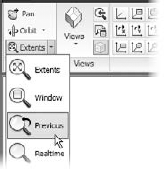
Do this now and the previous view—the one showing the entire clip—returns to the screen.
You can quickly enlarge or reduce your view by using the Zoom Realtime option of the Zoom command. Follow these steps to change your view with Zoom Realtime:
Click the Zoom tool on the status bar; then right-click and select Enter.

Place the Zoom Realtime cursor slightly above the center of the drawing area, and then click and drag downward. Your view zooms out to show more of the drawing.
While still holding the left mouse button, move the cursor upward. Your view zooms in to enlarge your view. When you have a view similar to the one shown in Figure 1.15, release the mouse button. (Don't worry if you don't get exactly the same view as the figure. This is just for practice.)
You're still in Zoom Realtime mode. Click and drag the mouse again to see how you can further adjust your view. To exit, you can select another command besides a Zoom or Pan, press the Esc key, or right-click your mouse and choose Exit from the shortcut menu.
Right-click now and choose Exit from the shortcut menu to exit the Zoom Realtime command.
If you prefer, you can use the wheel on your mouse to zoom and pan over your view. Roll the wheel to zoom in and out or click and drag the wheel to pan.
As you can see from this exercise, you have a wide range of options for viewing your drawings, just by using a few tools. These tools are all you need to control the display of 2D drawings.
It's a good idea to save your file periodically as you work on it. As with any Windows program, you can save it under its original name (click the Save tool on the Quick Access toolbar) or under a different name (choose Save As from the Application menu), thereby creating a new file.
By default, AutoCAD automatically saves your work at 10-minute intervals under a name that is a combination of the current filename plus a number and that ends with the .sv$ filename extension; this is known as the Automatic Save feature. Using settings in the Options dialog box or system variables, you can change the name of the autosaved file and control the time between autosaves. See "The Open and Save Tab" in Appendix B for details.
You'll frequently make changes to your drawings. One of AutoCAD's primary advantages is the ease with which you can make changes. The following exercise shows you a typical sequence of operations involved in changing a drawing:
Use the Save As option in the Application menu to save the current
Clip.dwgfile under the name MyFirst. For convenience, you can save your files in theMy Documentsfolder.
Notice that the cursor has turned into a small square. This square is called the pickbox. You also see
Select objects:in the Command window and the Dynamic Input display. This message helps remind new users what to do.Move the pickbox over the drawing, placing it on various parts of the clip. Don't click anything yet. Notice that as you hover your cursor over objects with the pickbox, they're highlighted. This helps you see the objects that the pickbox is likely to select should you click the left mouse button.
Place the pickbox on the crosshatch pattern of the clip (see Figure 1.16), and click. The crosshatch changes in appearance from a dark highlight to a light highlight. The pickbox and the
Select objects:prompt remain, indicating that you can continue to select objects.Press

In this exercise, first you issued the Erase command, and then you selected an object by using a pickbox to click it. The pickbox tells you that you must select items on the screen, and it shows you what you're about to select by highlighting objects as you hover the cursor over them. Once you've clicked an object or a set of objects, press
You can also click an object or a set of objects and then press the Delete key.
You can have multiple documents open at the same time in AutoCAD. This can be especially helpful if you want to exchange parts of drawings between files or if you want another file open for reference. Try the following exercise to see how multiple documents work in AutoCAD:

If you see the Create New Drawing dialog box after step 1, click the Start from Scratch button and select Imperial; then click OK and AutoCAD will display a default document. You'll learn more about the Create New Drawing dialog box in Chapter 3.
Make sure
acad.dwtis selected, and then click Open.Click the View tab's Window panel, and then click Tile Vertically to get a view of both drawing files.
When you create a new file in AutoCAD, you're actually opening a copy of a template file, as you saw in step 1. A template file is a blank file that is set up for specific drawing types. The acad.dwt file is a generic template set up for Imperial measurements. Another template file called acadiso.dwt is a generic template useful for metric measurements. Other templates are set up for specific drawing-sheet sizes and measurement systems. You'll learn more about templates in Chapter 6.
Next, let's try drawing a rectangle to see how AutoCAD behaves while drawing objects:
Click the Rectangle tool in the Home tab's Draw panel.

Notice that the Command window and the message at the cursor now shows the following prompt:
Specify first corner point or [Chamfer/Elevation/Fillet/Thickness/Width]:
AutoCAD is asking you to select the first corner for the rectangle and, in brackets, it's offering a few options that you can take advantage of at this point in the command. Don't worry about those options right now. You'll have an opportunity to learn about command options in Chapter 2. You also see the same prompt, minus the bracketed options, in the Dynamic Input display at the cursor.
Click a point roughly in the lower-left corner of the drawing area, as shown in Figure 1.17. Now, as you move your mouse, a rectangle follows the cursor, with one corner fixed at the position you just selected. You also see the following prompt in the Command window, with a similar prompt in the Dynamic Input display:
Specify other corner point or [Area/Dimensions/Rotation]:
Click another point anywhere in the upper-right region of the drawing area. A rectangle appears (see Figure 1.18). You'll learn more about the different cursor shapes and what they mean in Chapter 2.
Let's try copying objects between these two files. Click in the window with the clip drawing to make it active.
Click All from the Zoom flyout in the View tab's Navigate panel to get an overall view of the drawing. You can also click the Zoom tool in the status bar and type A

Click the 2D version of the clip at the bottom of the drawing to select it. A series of squares and arrows appears on the drawing. These are called grips, and you'll learn more about them in the next chapter (see Figure 1.20).
Click inside the other drawing window to make it active.
Right-click and select Paste. The clip appears at the cursor in the new drawing.
Position the clip in the middle of the rectangle you drew earlier and left-click the mouse. The clip is copied into the second drawing.
This ends the exercises for this chapter. Save the file and then exit AutoCAD.
Note that you've had two files open at once. You can have as many files open as you want as long as your computer has adequate memory to accommodate them. You can control the individual document windows as you would any window, using the Window drop-down menu or the window control buttons in the upper-right corner of the document window.
In the preceding exercise, you saw how you can easily copy an object from one file to another by using the standard Windows Cut and Paste feature. AutoCAD offers several tool palettes that enable you to click and drag predrawn objects into your drawing.
You can open the tool palettes by clicking the Tool Palettes tool in the View tab's Palettes panel.

Once the tool palettes are open, you can select a tab in the Tool Palettes window containing the predrawn objects you want to use and then click the specific object you want to add. The object appears at the cursor, ready for you to select a location (see Figure 1.21).
In addition to predrawn objects, the tool palettes offer a way to add hatch patterns and other components quickly to your drawing. They're great tools to help you manage your library of custom, predrawn symbols. Chapter 29 shows you how to use and customize the tool palettes.
- Use the AutoCAD window
AutoCAD is a typical Windows graphics program that makes use of menus, toolbars, Ribbon panels, and palettes. If you've used other graphics programs, you'll see at least a few familiar tools.
- Master It
Name the components of the AutoCAD window you can use to select a function.
- Get a closer look with the Zoom command
One of the first things you'll want to learn is how to manipulate your views. The Zoom command is a common tool in graphics programs.
- Master It
Name at least two ways of zooming into a view.
- Save a file as you work
Nothing is more frustrating than having a power failure cause you to lose hours of work. It's a good idea to save your work frequently. AutoCAD offers an autosave feature that can be a lifesaver if you happen to forget to save your files.
- Master It
How often does the AutoCAD autosave feature save your drawing?
- Make changes and open multiple files
As with other Windows programs, you can have multiple files open and exchange data between them.
- Master It
With two drawings open, how can you copy parts of one drawing into the other?


